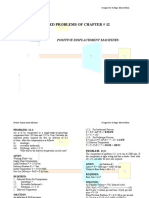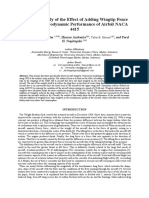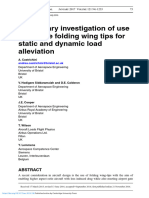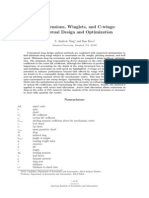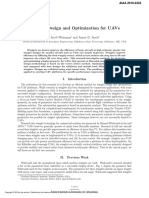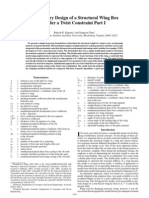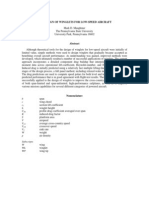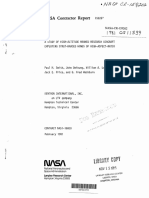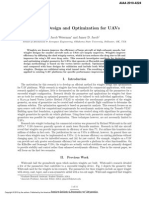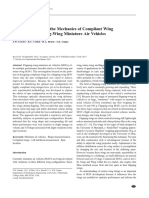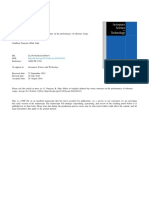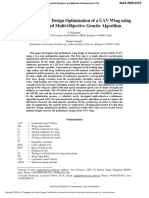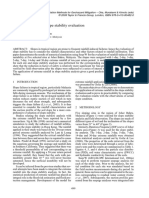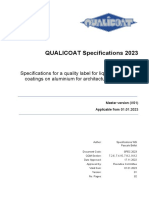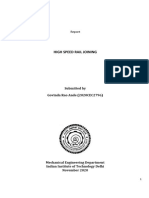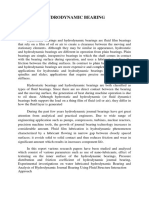CoefficientOfDrag Report Updated2
CoefficientOfDrag Report Updated2
Uploaded by
DEVANSH DHRAFANICopyright:
Available Formats
CoefficientOfDrag Report Updated2
CoefficientOfDrag Report Updated2
Uploaded by
DEVANSH DHRAFANIOriginal Description:
Copyright
Available Formats
Share this document
Did you find this document useful?
Is this content inappropriate?
Copyright:
Available Formats
CoefficientOfDrag Report Updated2
CoefficientOfDrag Report Updated2
Uploaded by
DEVANSH DHRAFANICopyright:
Available Formats
Establishing relation between coefficient of drag and wing sweep angle of an airplane
using a drop test with accelerometer
Aryan Chaudhary, Devansh Dhrafani, Gattem Sai Govind, Vadranam
Manikanth, Vishal Prabu, Meenakshi Viswanathan, Aravinda Raghavan∗
BITS Pilani, Hyderabad Campus
(Dated: July 19, 2020)
Wing Sweep Angle and Coefficient of Drag are important parameters for any aircraft design. In
this experiment, we hypothesize that within bounds of experimental error, there exists a relation
between Wing Sweep angle and Coefficient of Drag for any aircraft design. Traditional methods for
finding drag coefficient like Wind Tunnel testing and CFD Simulations are tricky to set up, time
consuming and expensive-both cost wise and computationally. Instead, we use a low cost, easy to
setup drop test method to calculate the drag coefficient of the model aircraft. A model aeroplane
with an accelerometer attached in its nose was dropped from a fixed height. The accelerometer data
was then analysed to find the Coefficient of Drag. The same experiment is performed with various
Sweep Angles to find a relation between Sweep Angle and Drag Coefficient.
Items used: Wooden planks, screws, nylon thread, accelerometer components, solder, thermocol planes, surgical
blades, and high speed camera.
I. INTRODUCTION
The wings of aircraft are bent backwards [1] (forward
occasionally) at an angle from its root rather than
perpendicular to the fuselage. The angle with respect to
normal of the fuselage at which the wing is bent is called
the sweep angle. Sweeping the wing back increases
the critical mach number and delivers higher lift-drag
ratio, thereby improving performance. Early fighter jets
capable of flying at subsonic speeds benefited greatly Fig 1: Coefficient of Drag is constant for Reynolds
with the introduction of swept wings. The amount of number range of 103 − 105 [4]
drag is directly proportional to the amount of air that
is flowing perpendicular to the wing or airflow in the The height of the experiment was chosen such that
plane of air-foil cross-section. This drag can be reduced drag coefficient is independent of Reynold’s number and
by introducing Sweep Angle. When sweep angle is the model airplane does not attain terminal velocity. We
introduced, the amount of air flowing perpendicular to used an accelerometer (MPU 6050) to measure the in-
the wing–that is the span-wise component of the air stantaneous acceleration of the airplane as it is dropped.
flow– decreases, which results in the wave-drag on the
wing and consequently the plane decreasing.
A typical airplane design process takes around 2.5
million Computational Fluid Dynamics simulations
before an acceptable result is obtained.[2] Wind Tunnel
experiments are difficult and expensive to set up. We
implement a simple, cost effective drop test method to
find the Coefficient of Drag (Cd). Such drop tests have
been conducted earlier to estimate Cd of rockets.[3] In
this experiment, A model airplane is dropped vertically
from a certain height. It has been observed that the
drag coefficient of any object is almost constant in the Fig 2: Experimental setup for drop test
range 1000 - 100000 Reynold’s number range.[4]
The sensor was fixed in the nose of the airplane. With
the obtained acceleration vs time data, one can extrap-
olate to find the terminal velocity of the falling air-
plane and thus get the Coefficient of Drag for the model
∗ Performed under supervision of Physics Department,BITS Pi- airplane.[3] This experiment was repeated for different
lani, Hyderabad Campus. sweep angles of the model airplane to find the relation
2
between Wing Sweep angle and Coefficient of Drag. II. REFERENCES
[1] S. Siouris and N. Qin, Study of the effects of wing sweep to Optimal Control of Airflow in Inlet, Ph.D. thesis (2006).
on the aerodynamic performance of a blended wing body [3] S. P. Fors and C. Nord, Determination of aerodynamic
aircraft, Proceedings of the Institution of Mechanical En- drag coefficients using a drop test with a wireless ac-
gineers, Part G: Journal of Aerospace Engineering 221, celerometer and its application to model rockets, Amer-
47 (2007). ican Journal of Physics 87, 714–719 (2019).
[2] A. Jirasek, Vortex Generator Modeling and its Application [4] F. M. White, Fluid Mechanics, seventh ed. (McGraw Hill
Education, 2011) pg 500.
You might also like
- MRI Study GuideDocument66 pagesMRI Study GuideJuan Doval100% (10)
- McConkey Manual Solution Chapter 12Document8 pagesMcConkey Manual Solution Chapter 12densnnow100% (3)
- The Design and Construction of Flying Model AircraftFrom EverandThe Design and Construction of Flying Model AircraftRating: 5 out of 5 stars5/5 (2)
- MIT 8.421 NotesDocument285 pagesMIT 8.421 NotesLucille Ford100% (1)
- Electric Submersible Pump BasicsDocument146 pagesElectric Submersible Pump BasicsAbhoe Stank100% (6)
- Itmconf Cmes-17 07008Document6 pagesItmconf Cmes-17 07008j2002dabdNo ratings yet
- Hermanto - OIC - MMIE 2022Document7 pagesHermanto - OIC - MMIE 2022Bung HaFiedNo ratings yet
- Aerodynamic Data Generation TechniquesDocument21 pagesAerodynamic Data Generation TechniquesThiago BoaventuraNo ratings yet
- FuselageDocument11 pagesFuselageRyanNo ratings yet
- An Investigation of The Aerodynamic Efficiency of Tailess AircraftDocument9 pagesAn Investigation of The Aerodynamic Efficiency of Tailess AircraftPaul Pipi OkonkwoNo ratings yet
- COBEM2007 UavDocument10 pagesCOBEM2007 UavFred FreddyNo ratings yet
- Flutter and Directional Stability of AircraftDocument12 pagesFlutter and Directional Stability of AircraftdaliadavidkNo ratings yet
- Aerodynamics of Winglet: A Computational Fluid Dynamics StudyDocument17 pagesAerodynamics of Winglet: A Computational Fluid Dynamics StudyAntonio RodriguesNo ratings yet
- Zbook Ijret20170606015 FdaaeDocument6 pagesZbook Ijret20170606015 FdaaeŞevki SağlamNo ratings yet
- Towards Higher Aerodynamic Efficiency of Propeller Driven Aircraft With Distributed PropulsionDocument15 pagesTowards Higher Aerodynamic Efficiency of Propeller Driven Aircraft With Distributed PropulsionwharNo ratings yet
- JAFM - Volume 17 - Issue 6 - Pages 1182-1190Document9 pagesJAFM - Volume 17 - Issue 6 - Pages 1182-1190jatmikowpNo ratings yet
- Analysis of The Impact of Trailing-Edge Wing FlapsDocument10 pagesAnalysis of The Impact of Trailing-Edge Wing FlapsNL NapsNo ratings yet
- Computational Aerodynamic Modeling For Flight DynamicsDocument30 pagesComputational Aerodynamic Modeling For Flight Dynamicsuma shankarNo ratings yet
- 2 D Flexible WingDocument14 pages2 D Flexible WingMert BağrıyanıkNo ratings yet
- P46-Investigations On The Shape Optimization of Naca0012Document13 pagesP46-Investigations On The Shape Optimization of Naca0012Mohi AnsarNo ratings yet
- Model-Based Wind Estimation For A Hovering VTOL Tailsitter UAVDocument8 pagesModel-Based Wind Estimation For A Hovering VTOL Tailsitter UAVcesarNo ratings yet
- 01jul201605072213 Pon Maa Kishan A 763-767 PDFDocument5 pages01jul201605072213 Pon Maa Kishan A 763-767 PDFJeTengine EaterNo ratings yet
- Reverse Engineering and Aerodynamic Analysis of A Flying Wing UAV ATSChandranDocument13 pagesReverse Engineering and Aerodynamic Analysis of A Flying Wing UAV ATSChandrancsulbstudent1No ratings yet
- Jten 2023 9 5.20539Document12 pagesJten 2023 9 5.20539quocdinh leNo ratings yet
- A Comparative Aerodynamic Study of Nonplanar WingsDocument29 pagesA Comparative Aerodynamic Study of Nonplanar WingsFelice NickNo ratings yet
- Winglet Multi-Objective Shape OptimizationDocument17 pagesWinglet Multi-Objective Shape OptimizationDerekNo ratings yet
- Riyanferdiyanto 17117003 Pengecoran Dan Heat Treatment LogamDocument10 pagesRiyanferdiyanto 17117003 Pengecoran Dan Heat Treatment LogamRiyan FerdiyantoNo ratings yet
- Jjmie: Design Analysis and Modeling of A General Aviation AircraftDocument9 pagesJjmie: Design Analysis and Modeling of A General Aviation AircraftDario ForestiereNo ratings yet
- preliminary-investigation-of-use-of-flexible-folding-wing-tips-for-static-and-dynamic-load-alleviationDocument22 pagespreliminary-investigation-of-use-of-flexible-folding-wing-tips-for-static-and-dynamic-load-alleviationMajid AhmadiNo ratings yet
- Tip Extensions, Winglets, and C-Wings: Conceptual Design and OptimizationDocument33 pagesTip Extensions, Winglets, and C-Wings: Conceptual Design and Optimizationfelo82No ratings yet
- A Generic Global Aerodynamic Model For AircraftDocument24 pagesA Generic Global Aerodynamic Model For AircraftAshwani SinghNo ratings yet
- Aiaa 2010 4224Document14 pagesAiaa 2010 4224JameyJacobNo ratings yet
- Experimental Aerodynamic Analysis of Delta WingDocument9 pagesExperimental Aerodynamic Analysis of Delta WingSharan Teja ElagandulaNo ratings yet
- Winglet PerformanceDocument8 pagesWinglet PerformanceCATIA BACKUPNo ratings yet
- Skhosravi Dwzingg JoADocument37 pagesSkhosravi Dwzingg JoACATIA BACKUPNo ratings yet
- EslamDocument11 pagesEslamesport.afsarNo ratings yet
- CFD Analysis On Mav Naca Wing in High Lift Takeoff Configuration For Enhanced Lift Generation 2168 9792.1000125Document8 pagesCFD Analysis On Mav Naca Wing in High Lift Takeoff Configuration For Enhanced Lift Generation 2168 9792.1000125ratmuhyakaNo ratings yet
- Aerodynamic Analysis of Variable Cant Angle Winglets For Improved Aircraft PerformanceDocument7 pagesAerodynamic Analysis of Variable Cant Angle Winglets For Improved Aircraft Performancelado prakasaNo ratings yet
- Numerical and Experimental Investigation of Aerodynamics Characteristics of NACA 0015 AerofoilDocument10 pagesNumerical and Experimental Investigation of Aerodynamics Characteristics of NACA 0015 Aerofoilmiguel sebastian rincon ortega0% (1)
- Aeroelasticity ThesisDocument5 pagesAeroelasticity Thesisb0sus1hyjaf2100% (1)
- Aiaa 2010 4224 PDFDocument14 pagesAiaa 2010 4224 PDFMohamed MansourNo ratings yet
- Preliminary Design of A Structural Wing Box Under A Twist Constraint Part IDocument10 pagesPreliminary Design of A Structural Wing Box Under A Twist Constraint Part ITrenton EnglishNo ratings yet
- The Design of Winglets For Low-Speed AircraftDocument18 pagesThe Design of Winglets For Low-Speed Aircraftbarat3786100% (1)
- A Study of High-Altitude Manned Research Aircraft Employing Strut-Braced Wings of High-Aspect-Ratio - NASA CR-159262 - Smith, DeYoung, Lovell, Price, WashburnDocument94 pagesA Study of High-Altitude Manned Research Aircraft Employing Strut-Braced Wings of High-Aspect-Ratio - NASA CR-159262 - Smith, DeYoung, Lovell, Price, WashburnodehNo ratings yet
- 2018 1 X Y HamadaDocument28 pages2018 1 X Y HamadaGaurav Kumar ThakurNo ratings yet
- J Matpr 2021 02 127Document6 pagesJ Matpr 2021 02 127Anh NgoNo ratings yet
- SimulaciónDocument10 pagesSimulaciónJose Luis RomanNo ratings yet
- Reference 6 Ajit Thesis On Thethered AirshipDocument241 pagesReference 6 Ajit Thesis On Thethered AirshipDharmendra PatelNo ratings yet
- Aiaa 2010 4224Document14 pagesAiaa 2010 4224asafajrNo ratings yet
- Analysis On Propeller Design For Medium-Sized Drone (DJI Phantom 3)Document5 pagesAnalysis On Propeller Design For Medium-Sized Drone (DJI Phantom 3)Pooja BanNo ratings yet
- 214-Study of Aerodynamics Characteristic of BWB Baseline-IIDocument4 pages214-Study of Aerodynamics Characteristic of BWB Baseline-IIFizz Azmi0% (1)
- Experimental Investigation of Flow Separation Control Over Airfoil by Upper Surface Flap With A GapDocument11 pagesExperimental Investigation of Flow Separation Control Over Airfoil by Upper Surface Flap With A Gapstud016295No ratings yet
- Aircraft Trajectory Simulator Using A Three Degrees of Freedom Aircraft Point Mass ModelDocument6 pagesAircraft Trajectory Simulator Using A Three Degrees of Freedom Aircraft Point Mass ModelMinase TesmaNo ratings yet
- Aerodynamics Analysis of Famly Aerofoil Using Computational FluidDocument13 pagesAerodynamics Analysis of Famly Aerofoil Using Computational FluidSagar kumar Mec.No ratings yet
- CFD Analysis of The Aerodynamic Characteristics of Swept Back Wing by Changing Its Taper RatioDocument6 pagesCFD Analysis of The Aerodynamic Characteristics of Swept Back Wing by Changing Its Taper RatioTJPRC PublicationsNo ratings yet
- Characterization of The Mechanics of Compliant Wing Designs For Flapping-Wing Miniature Air VehiclesDocument11 pagesCharacterization of The Mechanics of Compliant Wing Designs For Flapping-Wing Miniature Air VehiclesZahid Hameed QaziNo ratings yet
- Aircraft Winglets 2 PDFDocument26 pagesAircraft Winglets 2 PDFAlen S T100% (1)
- Mathematical Modelling of Engineering Problems: Received: 10 September 2021 Accepted: 16 March 2022Document5 pagesMathematical Modelling of Engineering Problems: Received: 10 September 2021 Accepted: 16 March 2022EMRE DEMIRCINo ratings yet
- Czyż 2021 J. Phys.: Conf. Ser. 1736 012045Document8 pagesCzyż 2021 J. Phys.: Conf. Ser. 1736 012045king kingNo ratings yet
- Manuscript MG RMDocument13 pagesManuscript MG RMLerry AnsaldiNo ratings yet
- Multidisciplinary Design Optimization of A UAV Wing Using KrigingDocument18 pagesMultidisciplinary Design Optimization of A UAV Wing Using KrigingŘøm ËõNo ratings yet
- Design and Fabrication of Unmanned Arial Vehicle For Multi-Mission TasksDocument10 pagesDesign and Fabrication of Unmanned Arial Vehicle For Multi-Mission TasksTJPRC PublicationsNo ratings yet
- Analysis of Four Wave Mixing Final Year ProjectDocument1 pageAnalysis of Four Wave Mixing Final Year ProjectNauman HameedNo ratings yet
- Extreme Rainfall For Slope Stability EvaDocument6 pagesExtreme Rainfall For Slope Stability EvaJosif JosifovskiNo ratings yet
- Tides Are The Rise and Fall of Sea Levels Caused by The Combined Effects of Gravitational Forces Exerted by The MoonDocument4 pagesTides Are The Rise and Fall of Sea Levels Caused by The Combined Effects of Gravitational Forces Exerted by The Moonapi-286301523No ratings yet
- MDP4540 Creep Failure SheetDocument2 pagesMDP4540 Creep Failure Sheet154 ahmed ehabNo ratings yet
- Melt Spinning: V UK Sathrajith 19Y127Document11 pagesMelt Spinning: V UK Sathrajith 19Y12719Y203 - AMITH B KNo ratings yet
- Fluid Machinery Lecture Notes PDFDocument74 pagesFluid Machinery Lecture Notes PDFMark Angelo UyNo ratings yet
- Qualicoat Specifications 2023 - Master Version - V01Document92 pagesQualicoat Specifications 2023 - Master Version - V01idelcio rochaNo ratings yet
- Chapter 5 WorksheetDocument6 pagesChapter 5 WorksheetJules BrunoNo ratings yet
- Work Energy PowerDocument40 pagesWork Energy PowerJames MaxwellNo ratings yet
- Electrochemical CellsDocument63 pagesElectrochemical CellsHoongNo ratings yet
- KMT ws2Document10 pagesKMT ws2Troy MateoNo ratings yet
- Jepretan Layar 2023-07-08 Pada 18.01.57Document1 pageJepretan Layar 2023-07-08 Pada 18.01.57luky ivanNo ratings yet
- Name: Sajeel Khan Roll#:M.phil-SSP-03-F19 Class: M.phil SSP (Morning) Subject: Optical Properties of Solid Submitted TODocument8 pagesName: Sajeel Khan Roll#:M.phil-SSP-03-F19 Class: M.phil SSP (Morning) Subject: Optical Properties of Solid Submitted TOAnonymous f7wV1lQKRNo ratings yet
- Finite Element Analysis of Skirt To Dished Junction in A Pressure VesselDocument4 pagesFinite Element Analysis of Skirt To Dished Junction in A Pressure VesselIJMERNo ratings yet
- 02 GG Pgt25 Dle Description VCNGDocument138 pages02 GG Pgt25 Dle Description VCNGolegprikhodko2809100% (5)
- Welding Report - 2020CEC2796Document20 pagesWelding Report - 2020CEC2796Govind Rao AndeNo ratings yet
- Solution: A B A BDocument3 pagesSolution: A B A BMOHD FIRDAUS BIN JAAFAR / UPMNo ratings yet
- Morino - 1986 Helmholtz Decomposition Revisited Vorticity Generation and Trailing Edge ConditionDocument26 pagesMorino - 1986 Helmholtz Decomposition Revisited Vorticity Generation and Trailing Edge ConditionproscribdNo ratings yet
- Ncert 11 Part A Practice Paper PhysicsDocument16 pagesNcert 11 Part A Practice Paper Physicskavyamanchanda102No ratings yet
- 1ST Term Xii Physics 2021Document12 pages1ST Term Xii Physics 2021RiyazNo ratings yet
- Merchant Navy Interview QuestionDocument3 pagesMerchant Navy Interview Questionvardhanyash100% (5)
- Hydrodynamic Bearing PDFDocument4 pagesHydrodynamic Bearing PDFAndrey ZagorulkoNo ratings yet
- DNVGL RP C104Document103 pagesDNVGL RP C104KenginNo ratings yet
- Comparison of The Seismic Performance of Equivalent Straight and Curved Bridges - KopijaDocument10 pagesComparison of The Seismic Performance of Equivalent Straight and Curved Bridges - Kopijagrobardogroba1211No ratings yet
- Steel Pipelines Crossing Railroads & Highways API RP1102Document35 pagesSteel Pipelines Crossing Railroads & Highways API RP1102vijay pitchai100% (2)
- RAP 07 Fluids HW KeyDocument7 pagesRAP 07 Fluids HW KeyChandrea WillardNo ratings yet


